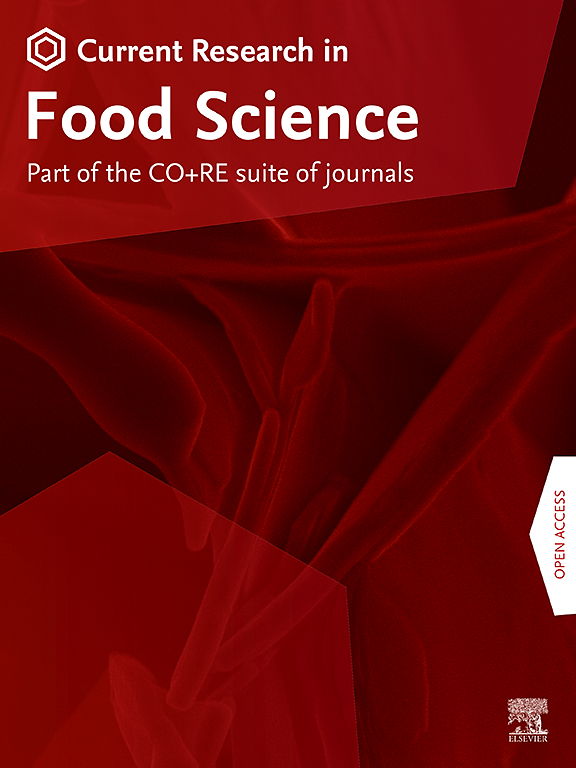Encapsulation of menthol by cyclodextrins-comparison between experiments and molecular simulations
IF 6.2
2区 农林科学
Q1 FOOD SCIENCE & TECHNOLOGY
引用次数: 0
Abstract
Cyclodextrins (CDs) are a traditional wall material for encapsulating flavor ingredients. Given the substantial structural differences among flavor ingredients, experimentally deriving the selection criteria for CDs suitable for these flavor substances is a time-consuming process. However, most existing literature relies on the embedding efficiency from practical experiments to evaluate the binding effect between flavor ingredients and CDs. This article used menthol as the research subject and investigated the binding effects of three different CDs through experiments and computer simulations. The experimental results revealed that β-CD exhibited the optimal encapsulation efficiency (EE, 36.54%) on menthol, subsequently, γ-CD showed a 33.35% EE value, whereas α-CD was unable to form an inclusion complex (IC) with menthol. Conformation changes, root mean square deviation (RMSD), radius of gyration (Rg), Radial distribution function (RDF), solvent accessible surface area (SASA), and hydrogen bonds, and binding free energy were analyzed through molecular dynamics simulation and compared with the experimental results. The results indicated that the IC formed between β-CD and menthol (menthol/β-CD-IC) is the most stable, with a binding free energy (ΔGbind) of −7.27 kcal/mol. The IC formed between α-CD and menthol (menthol/α-CD-IC) is the least stable one (ΔGbind = 2.59 kcal/mol). The results revealed a high degree of consistency between the experimental outcomes and those of molecular simulation, so molecular simulation can serve as a more efficient screening method, an alternative to practical experiments, to obtain the combination ability between host-guest molecules.

环糊精包封薄荷醇的实验与分子模拟比较
环糊精(CDs)是一种传统的封装风味成分的壁材。由于风味成分之间存在巨大的结构差异,通过实验推导出适合这些风味物质的cd的选择标准是一个耗时的过程。然而,现有文献大多依赖于实际实验的嵌入效率来评估风味成分与cd之间的结合效果。本文以薄荷醇为研究对象,通过实验和计算机模拟研究了三种不同cd的结合效果。实验结果表明,β-CD对薄荷醇的包封效率最高(EE为36.54%),其次是γ-CD, EE为33.35%,而α-CD不能与薄荷醇形成包合物(IC)。通过分子动力学模拟分析了构象变化、均方根偏差(RMSD)、旋转半径(Rg)、径向分布函数(RDF)、溶剂可及表面积(SASA)、氢键和结合自由能,并与实验结果进行了对比。结果表明,β-CD与薄荷醇之间形成的IC(薄荷醇/β-CD-IC)最稳定,结合自由能(ΔGbind)为−7.27 kcal/mol。α-CD与薄荷醇形成的IC(薄荷醇/α-CD-IC)最不稳定(ΔGbind = 2.59 kcal/mol)。结果表明,实验结果与分子模拟结果具有高度的一致性,因此分子模拟可以作为一种更有效的筛选方法,替代实际实验来获得主-客体分子之间的结合能力。
本文章由计算机程序翻译,如有差异,请以英文原文为准。
求助全文
约1分钟内获得全文
求助全文
来源期刊

Current Research in Food Science
Agricultural and Biological Sciences-Food Science
CiteScore
7.40
自引率
3.20%
发文量
232
审稿时长
84 days
期刊介绍:
Current Research in Food Science is an international peer-reviewed journal dedicated to advancing the breadth of knowledge in the field of food science. It serves as a platform for publishing original research articles and short communications that encompass a wide array of topics, including food chemistry, physics, microbiology, nutrition, nutraceuticals, process and package engineering, materials science, food sustainability, and food security. By covering these diverse areas, the journal aims to provide a comprehensive source of the latest scientific findings and technological advancements that are shaping the future of the food industry. The journal's scope is designed to address the multidisciplinary nature of food science, reflecting its commitment to promoting innovation and ensuring the safety and quality of the food supply.
 求助内容:
求助内容: 应助结果提醒方式:
应助结果提醒方式:


